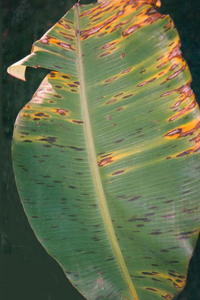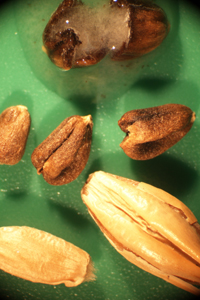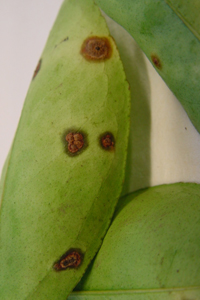The risk to Australia
Plant diseases cost Australia millions of dollars each year as they reduce productivity, increase the cost of production, impact on our ability to trade both locally and internationally and adversely affect our environment and biodiversity.



Note: images are not to size
Australia is free of many serious plant diseases such as karnal bunt of wheat, citrus greening, black sigatoka of banana and plum pox of stone fruit. While some plant diseases only affect a small number of plants, others can infect many different species. These exotic diseases, which can enter Australia on leaves, seed, fruit, roots and timber, pose a significant risk to both our plant industries and the environment.
What plant diseases look like
Plant diseases can infect any part of a plant and symptoms can vary. Disease symptoms can include leaf spots, lumps, cankers, colour changes (mottling, ring spots and lines), wilting, rots, malformed foliage, root galls and excessive growth.
What to look for
Since any part of a plant, from the seed to the roots, can be infected, look for anything unusual on seeds, fruit, leaves and other plant material including timber. Seeds may appear healthy but can still carry disease, so be sure to keep an eye out for them.
SEE. SECURE. REPORT.
If you see a biosecurity risk or suspected plant disease, secure the plant or goods to limit the spread of disease where possible and immediately report it to the Department of Agriculture, Fisheries and Forestryon 1800 798 636.
For safety, consult a departmental plant pathologist before handling diseased plants.
